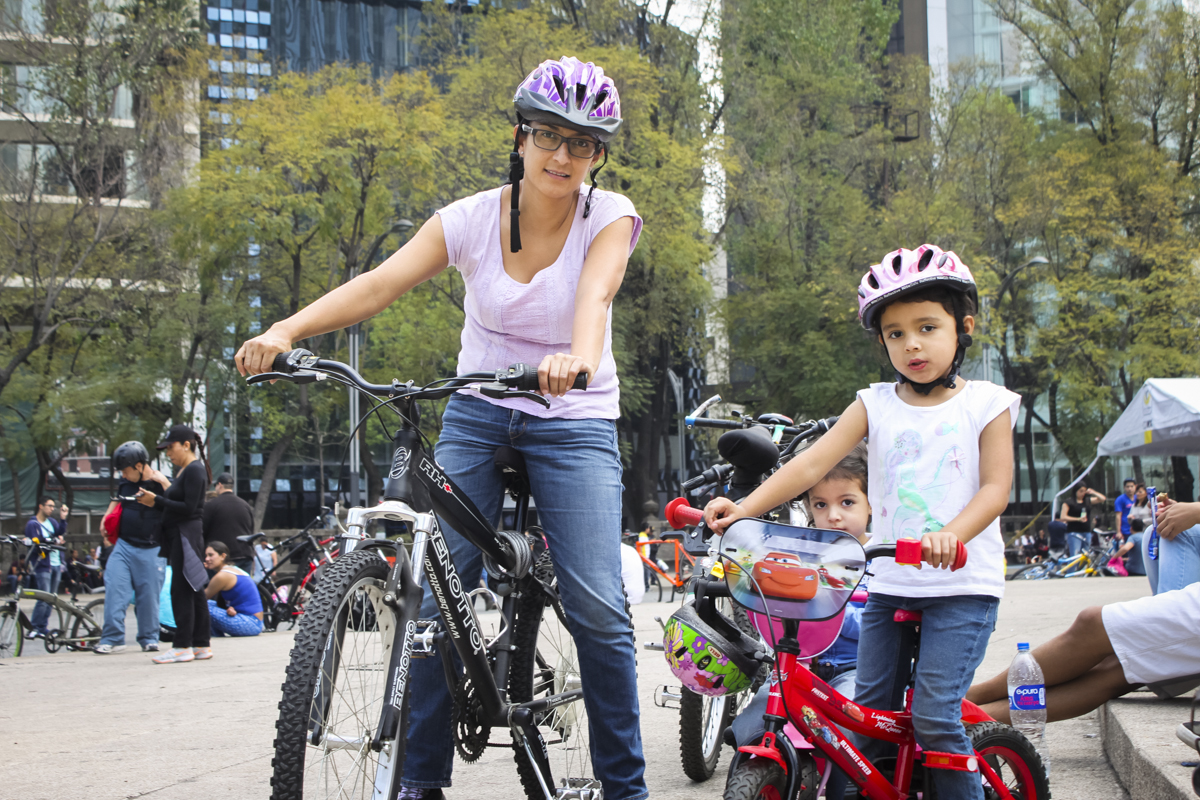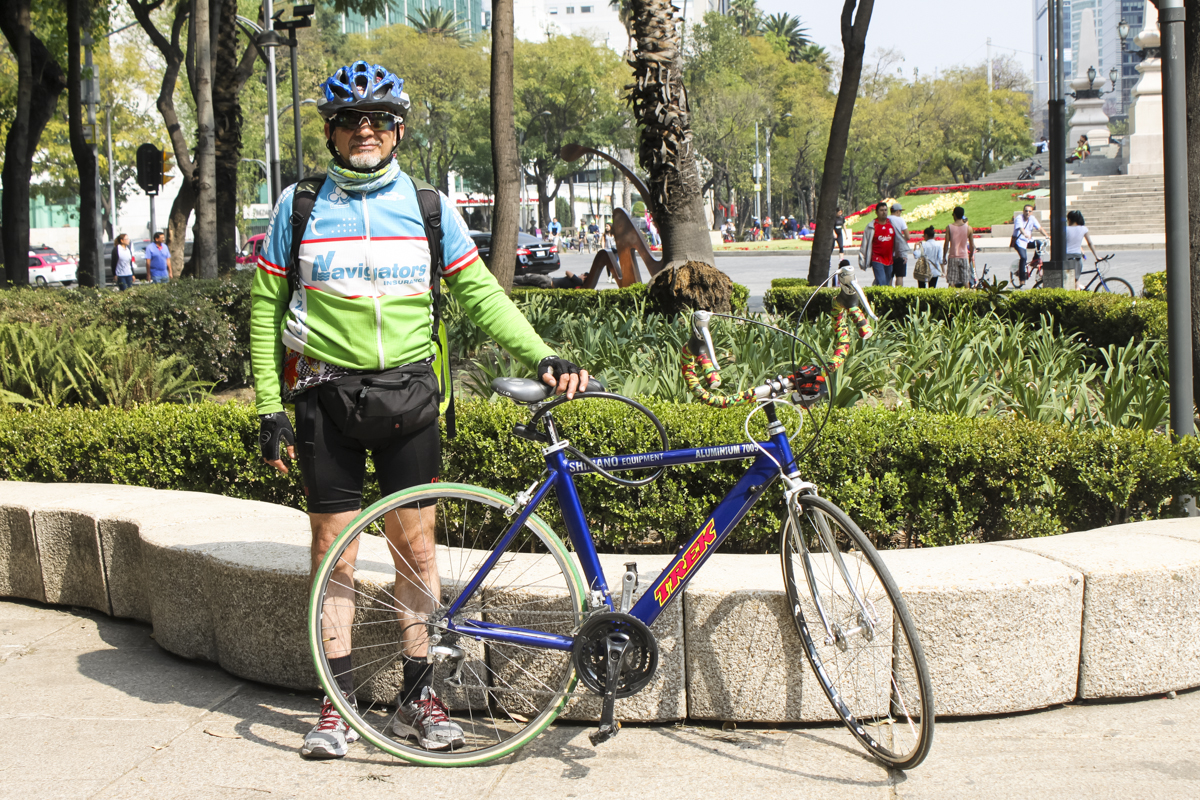
Mayela Sánchez, GPJ Mexico
Leslie Pastrana, 28, (left) and María Luisa Burelos, 26, wait to begin a group ride hosted by Bicitekas, one of Mexico City’s pioneering urban cycling groups. Group ride organizers say they arrange these events in order to teach cyclists how to be safe on the roads and to bring people together to have fun.
MEXICO CITY, MEXICO — More than 100 bicyclists prepare to hit the road here in this city that has long been known for traffic congestion.
“People get out of their cars because they can’t anymore,” says Patricio Ruiz Abrín, referring to a refusal among a growing number of people to drive in the city’s streets.
Ruiz is a member of Coalición Visión Cero, a coalition of cyclists, pedestrians and organizations working to ensure traffic safety.
“It’s very expensive to pay for and maintain a car while still losing daylight hours,” he adds.



Group rides are common now, says Ruiz, who is also the founder of Rodadas MX, which uses its social media channels to publicize upcoming rides, events and lifestyle and safety news. Through the coalition, he knows of more than 60 groups that ride every week.
But with more bicyclists on Mexico City’s roads, more people are injured or even killed in collisions with vehicles.
There were six bicycle-related deaths in Mexico City in 2013, according to Mexican government data.
The government registered 18 bicycle-related deaths from January to November 22, 2015.
Cyclist organizations reported 22 deaths in that same time frame. Cyclist advocates say their number is higher because they track people who’ve been injured on their bicycles for a longer period of time than the government does, and some of those people die from those injuries at a later date.
The number of deaths is in direct correlation to a growth in the number of cyclists. A report from the Institute for Transportation and Development Policy (ITDP) states that there was a 41.5 percent increase in the number of cyclists in Mexico City in 2011 from the previous year, and a 34.2 percent increase from 2011 to 2012. The institute is a global organization that helps cities find transportation solutions.
And bicyclists say they don’t plan to abandon their bikes. Instead, they’re promoting safety strategies, including new traffic regulations.
Last year, Bicitekas, one of Mexico City’s pioneering urban cycling groups, ITDP México and eight other groups presented the government with a set of recommended changes to transit law in Mexico City.
Among those changes: Both drivers and cyclists have obligations and responsibilities, including using lights or indicating lane changes with arm and hand motions, and not using cellphones while riding or driving.



The new regulations, published by the government in August 2015, also guarantee rights to cyclists, including priority passing and priority at intersections with or without a traffic light. When passing bicyclists, cars are to leave a protection zone of 1.5 meters (4.9 feet) between them and the bike riders.
Bicyclists who don’t comply with the regulations may get a verbal warning. Drivers of motorized vehicles who don’t comply face fines, most of which range from 358 Mexican pesos ($20.56) to 14,336 pesos ($823) for 2016, and they can lose points on their driving records. Drivers who accumulate 12 points within a year lose their licenses. Bicyclists and drivers can be arrested if they hit a pedestrian.
New bike lanes are also in the works, with 15 kilometers (9 miles) added to the current 49.6 kilometers (31 miles) of lanes by March 2016, says Tanya Müller García, the head of the Secretaría del Medio Ambiente, Mexico City’s environment ministry.
A ministry representative confirmed in a phone interview on March 23 that not all bike lanes had been constructed by the date, but they expect to finish by the end of April.
Urban cycling groups, including Bicitekas, are working to educate bicyclists about safety protocols.
Cycling groups are a big part of that education, says Pablo Ramírez, 37, founder of urban cycling group BiciOrientados. Riding together helps people become more comfortable about later riding on their own.
In many cities, drivers eventually acknowledge bicyclists, but it’s too soon to determine if or when that will happen in Mexico City, says Clara Vadillo, a specialist in non-motorized mobility projects for the Mexico City office of the ITDP.
Müller says the government is aware of the importance of bicycles as a means of transportation, and of the need to generate a driving culture that respects bicyclists.
The government is promoting a bike-sharing program as well as BiciEscuela, which provides urban cyclists with workshops and training on safety, their rights and bicycle repairs. (The name BiciEscuela combines the Spanish words for “bicycle” and “school.”)
There’s also a campaign to promote respect among drivers, cyclists and pedestrians. Many of the campaign signs can be seen throughout the streets, Müller says.
Vadillo says cyclists should continue to demand their rights until their presence is ingrained in the local culture.
“[I hope] that the cyclists don’t get off their bikes, even if there is bad news,” Vadillo says, referring to the possibility of more deaths. “Because bicycle mobility isn’t a [new] trend. And it’s very good for the city, because it’s even much nicer to have a more humane city.”
Rishi Khalsa and Natalia Aldana, GPJ, translated this article from Spanish.







